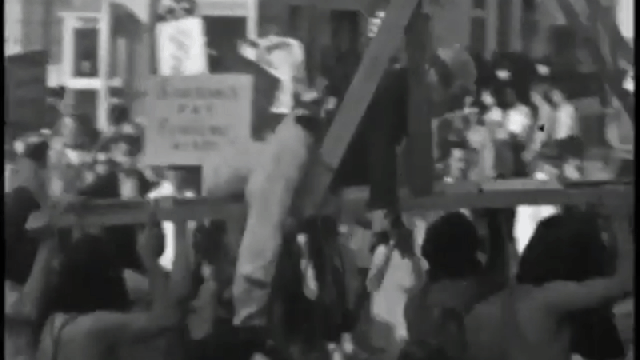Today, we often think of labour strikes as fairly mundane affairs. But there was a time when labour actions were much more intense. Like in 1941, when animators supporting the strike at Disney’s studio in Burbank, California brought a guillotine to show just how upset they were with Disney management over low wages at the studio.
By early 1941, many of the major animation studios, like Warner Bros. and Fleisher Studios, had unionised. But when the Screen Cartoonists Guild (SCG) tried to do the same at Disney, the studio’s management pushed back hard. Walt Disney threatened workers who were trying to organise with the SCG and by May of 1941, Disney fired two dozen people who had joined the union. One of the artists who was fired included Art Babbitt, an animator who worked on characters like the Wicked Queen in Snow White and the Seven Dwarfs.
Babbitt, one of Disney’s highest-paid animators at the time, was the lead organiser pushing for a union to help his fellow workers. Walt Disney had initially tried to stop his workers from organising by creating an “internal union” at the company, led by Babbitt, but the animator called bullshit and wanted the artists to be allowed to organise under the Screen Cartoonists Guild (SCG).
In the wake of the mass firing, artists at Disney had had enough and staged a strike the next day. The signs at the strike were well-illustrated, as you can imagine. But if you’ve ever seen a documentary that mentions the Disney strike in 1941, it probably doesn’t include the most radical aspects.
Animation studios that were already unionised came to show support for the Disney strike. And the merry pranksters at Warner Bros. even came to parade around a dummy made up to look like Disney’s attorney, Gunther Lessing, sitting inside a guillotine. The Warner Bros. revolutionaries, led by legendary animator Chuck Jones wearing a black mask, also had a sign that read, “Happy Birthday to Gunther and Walt.”
The guillotine wasn’t just a static symbol, either, as you can see from this GIF. The “blade” moved.
By mid-summer, Walt Disney was feeling some public pressure from people who favoured the striking workers, but the studio head took out magazine ads blaming the strike on “Communistic agitation.”
Things got so heated that Walt Disney took a run at some of the animators, apparently upset that he had to drive through the picket lines every day. Disney even took off his jacket to fight Babbitt, who was mocking him through a megaphone, before people could pull them apart.
From the book Drawing the Line: The Untold Story of the Animation Unions from Bosko to Bart Simpson by Tom Sito:
Art jumped up on a flatbed truck, grabbed a bullhorn and shouted, “There he is, the Great Man! He wants brotherhood for all except himself! Shame on you, Walt Disney!” Disney leapt out of his car and stripped off his jacket. A fistfight would have ensued had not cooler heads separated them.
Dave Hilberman recalled Walt Disney once gunning the Packard’s engine and braking just short of [Art Babbitt], showing how much Walt would like to hit him. One night when a rumour circulated that paid goons were going to beat up the strikers, [Herb] Sorrell sent a gang of Lockheed aircraft mechanics, monkey wrenches in hand, to guard the strikers’ tents. The rumour of violence luckily turned out to be just that, a rumour.
Other labour organisations showed solidarity to the striking workers and made it hard for Disney to do business. Technicolor refused to process Disney’s footage, printers refused to print the Mickey Mouse comic strip, and the American Federation of Labour (now part of the AFL-CIO) called for a boycott of all Disney products.
The U.S. federal government sent a judge to mediate the dispute, but Walt Disney wasn’t having it. He was an angry man and wasn’t about to let his workers win anything. It was only after Disney left for South America to conduct research for films that would hopefully coax those countries not to side with the Axis powers in World War II, that anything got done. The strike was settled on July 28, 1941 and the workers got a raise, with many animators seeing their pay double. But Disney sabotaged the most high profile union agitators until they quit over the next few years.
Why is the guillotine not very well remembered from the 1941 Disney strike? That’s tough to say, but probably because people of the 21st century tend to be uncomfortable with radical labour actions, even if they’re just symbolic.
Unions are good, and so is striking when things get bad. Withholding your labour is one of the few actions you can take to get your boss to take notice. And while you don’t need to bring a guillotine, it can certainly help get the point across. The very public nature of the Disney strike is precisely what got it resolved after five weeks—guillotines and all. Art Babbitt was rehired as a condition of the strike ending and Disney has been a union shop ever since.
